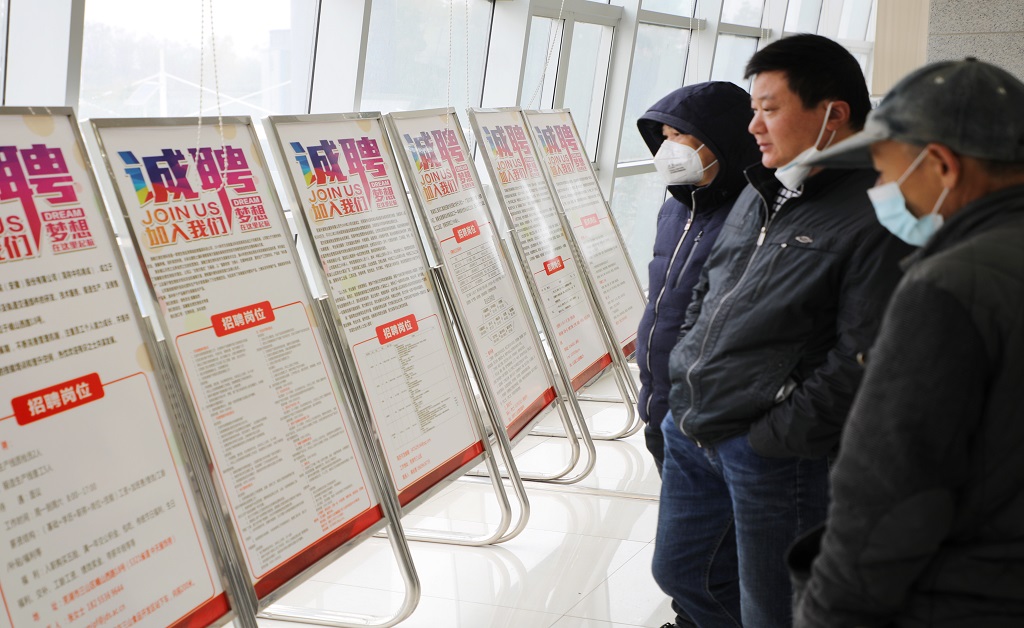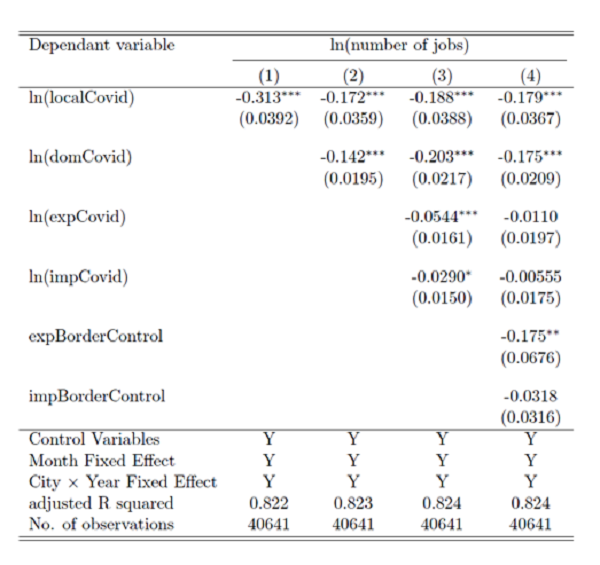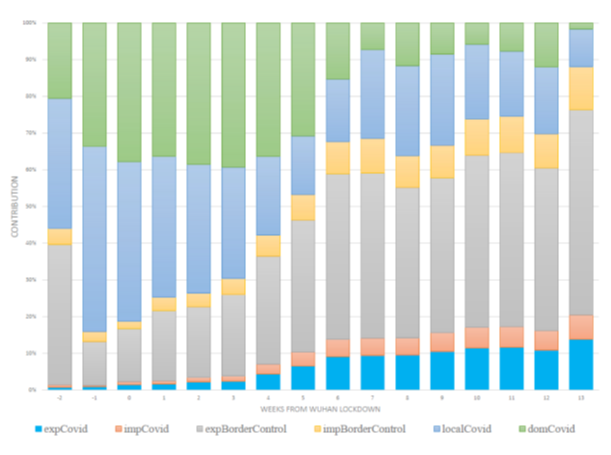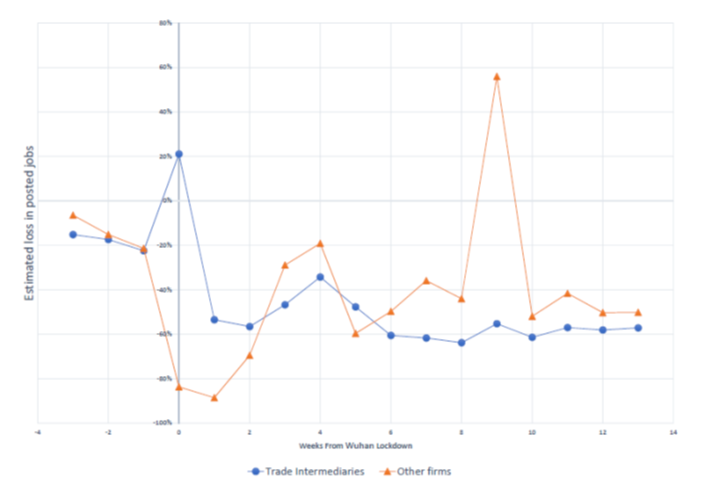The COVID-19 Pandemic and Job Creation: The Role of Global Supply Chains
Using big data of more than 100 million posted jobs from China, we estimate how the COVID-19 pandemic affected local labor demand in China via global supply chains. The data reveal that the number of newly posted jobs was about 31% lower in the first 14 weeks after the Wuhan lockdown than comparable periods in 2018 and 2019. We show that COVID-19 cases abroad and foreign governments’ pandemic-control policies reduced new job creation in China by 11.7%. We also find that firms most exposed to international trade outperformed others at the beginning of the pandemic but underperformed during the recovery as the epicenter moved outside China.

The COVID-19 pandemic has resulted in an enormous loss of life around the world. Measures taken by governments to contain the virus have flattened the epidemic curve and slowed the spread of the disease (Fang, Wang, and Yang 2020; Hsiang et al. 2020), but also have resulted in the loss of hundreds of millions of jobs and thrown the global economy into a deep recession. In an age in which most goods are “Made in the World,” there are worries that COVID-19 and pandemic-control policies could generate shock waves, transmitted via global supply chains, and impose economic costs that bypass national borders (Baldwin and Freeman 2020; Bonadio et al. 2020). Even though the pandemic is now well-contained in China, new waves and lockdowns in other parts of the world are likely to keep the highly opened Chinese economy under stress and dampen its recovery from the crisis.
In our recent study (Fang et al. 2020), we provide the first direct evidence that global supply chains have played a vital role in transmitting COVID-19 shocks and policies across borders. To understand the nexus of COVID-19, government pandemic-control policies, global supply chains, and China’s labor market, we exploit big data of more than 100 million posted jobs from a leading Chinese online employment platform. According to our data, in the first 14 weeks after the January 23, 2020 lockdown of Wuhan City—the first epicenter of COVID-19—the number of newly posted jobs dropped by about 31%, or 3.8 million, relative to the same lunar calendar period in 2018 and 2019.
Our empirical model correlates, at the city-week level, job creation with exposure to the pandemic in the city, in other parts of China, and to foreign countries through supply chains. Similar to other recent studies (Campello, Kankanhalli, and Muthukrishnan 2020; Forsythe et al. 2020), we first examine the impact of new COVID-19 cases in the local city on local job creation. We also separately identify the impact of COVID-19 in other parts of China by using a distance-weighted pandemic exposure measure. To test whether the pandemic has an impact on job creation through the global supply chain, we exploit cross-city variations in their exposure to the global pandemic and virus-containment policies through their differential trade linkages with other countries. Specifically, we create trade-weighted measures of exposure to the global pandemic by using Chinese Customs data to generate weights and to estimate their effects on job creation in a Chinese city. Thus, the variations come from changes in global pandemic and containment policies over time and a city’s exposure to trade with different countries.
As shown in Table 1, we find that COVID-19 cases in the local city and other parts of China have large negative impacts on job creation, and the elasticity of job creation with respect to the latter is slightly larger in magnitude. Second, foreign COVID-19 shocks transmitted via global supply chains also reduced job creation in China. This impact came mainly from the decline of export demand due to the policy responses to COVID-19 by foreign governments.
Table 1: COVID-19 shocks and local job creation

Note: This table estimates the impact of COVID-19 shocks on the number of weekly posted jobs across Chinese cities. ln(localCovid) and ln(domCovid) are the numbers of newly confirmed cases of the local city and the other domestic Chinese cities (weighted by distance). ln(expCovid) and ln(impCovid) capture pandemic outbreaks in trading partners using the number of newly confirmed cases weighted by a city’s exports and imports with each trading partner, respectively. Similarly, expBorderControl and impBorderControl are export- and import-weighted variables capturing border control policies implemented by foreign governments. The control variables are time dummies that capture major hiring seasons in spring and autumn. The numbers in the parentheses are robust standard errors clustered at the provincial level. Significance levels are indicated by *, **, *** at 0.1, 0.05, and 0.01, respectively.
To gauge the economic magnitude of the effects, we conduct a back-of-the-envelope calculation by computing the implied reduction in the number of jobs according to the estimated coefficients in Table 1 and the observed shock. The calculation implies that job creation was down by 9.6% due to local city COVID-19 cases, but by 10.7% due to cases in other parts of China in the 14 weeks after the Wuhan lockdown. In the same 14 weeks, foreign COVID-19 shocks reduced job creation in China by another 11.0%. The importance of each shock is also time-varying. According to Figure 1, which plots the contribution to reductions in job creation by component over time, when the epicenter was in China, the negative impact on job creation in a given city was due mostly to COVID-19 shocks in the local city and other domestic cities. As the pandemic surged in the rest of the world, the impact of foreign policy responses on export demand loomed large and became the primary shocks on Chinese local labor demand.
Figure 1: Contribution to reduction in job creation by component

Finally, as direct evidence of the role of international trade in transmitting the COVID-19 shock, we follow Ahn et al. (2011) to identify trade intermediary firms in our data by examining whether the names of firms contain Chinese terms related to trade. As demonstrated in Figure 2, trade intermediaries outperformed other types of firms in withstanding the COVID-19 shock when the epicenter was in China but underperformed during the recovery as the epicenter moved to the rest of the world.
Figure 2: Estimated loss in posted jobs by firm type

Understanding the transmission mechanism through domestic and international linkages is crucial for policymaking to speed up the recovery of the global economy. Our findings suggest that an open economy cannot fully recover unless the pandemic is well under control among all of its major trading partners. Thus, international coordination in pandemic control is crucial.
Our findings also have implications for China’s future trade and job creation beyond COVID-19. With deteriorating relations between China and the United States as well as other major Western countries, economic decoupling of China from the rest of the world or a sudden drop in China’s trade volume is becoming a real possibility. In light of this, the unprecedented COVID-19 pandemic and the subsequent virus mitigating border control policies adopted by foreign governments could serve as a natural “simulation” and be used as a rare opportunity to test how an abrupt severing of the global supply chain might affect job creation in China. We find large negative impacts of trade shocks, in particular, of the drop of foreign demand due to border control policies. Economic decoupling of China from the rest of the world will likely cause job losses in China in a similar manner, except that the magnitude of such a shock will likely be much larger (Bonadio et al. 2020).
(Hanming Fang, University of Pennsylvania, ShanghaiTech University, and National Bureau of Economic Research; Chunmian Ge, South China University of Technology; Hanwei Huang, City University of Hong Kong, and Centre for Economic Performance; Hongbin Li, Stanford University.)
References
Ahn, JaeBin, Amit K. Khandelwal, and Shang-Jin Wei. 2011. “The Role of Intermediaries in Facilitating Trade.” Journal of International Economics 84 (1), 73–85. https://doi.org/10.1016/j.jinteco.2010.12.003.
Baldwin, Richard, and Rebecca Freeman. 2020. “Supply Chain Contagion Waves: Thinking Ahead on Manufacturing ‘Contagion and Reinfection’ from the COVID Concussion.” VoxEU, April 1, 2020. https://voxeu.org/article/covid-concussion-and-supply-chain-contagion-waves.
Bonadio, Barthélémy, Zhen Huo, Andrei A. Levchenko, and Nitya Pandalai-Nayar. 2020. “Global Supply Chains in the Pandemic.” NBER Working Paper No. 27224. https://www.nber.org/papers/w27224.
Campello, Murillo, Gaurav Kankanhalli, and Pradeep Muthukrishnan. 2020. “Corporate Hiring under COVID-19: Labor Market Concentration, Downskilling, and Income Inequality.” NBER Working Paper No. 27208. https://www.nber.org/papers/w27208.
Fang, Hanming, Long Wang, and Yang Yang. 2020. “Human Mobility Restrictions and the Spread of the Novel Coronavirus (2019-nCoV) in China.” Journal of Public Economics 191 (November 2020). https://doi.org/10.1016/j.jpubeco.2020.104272.
Fang, Hanming, Chunmian Ge, Hanwei Huang, and Hongbin Li. 2020. “Pandemics, Global Supply Chains, and Local Labor Demand: Evidence from 100 Million Posted Jobs in China.” NBER Working Paper No. 28072. https://www.nber.org/papers/w28072.
Forsythe, Eliza, Lisa B. Kahn, Fabian Lange, and David Wiczer. 2020. “Labor Demand in the Time of COVID-19: Evidence from Vacancy Postings and UI Claims.” Journal of Public Economics 189 (September 2020). https://doi.org/10.1016/j.jpubeco.2020.104238.
Hsiang, Solomon, Daniel Allen, Sébastien Annan-Phan, Kendon Bell, Ian Bolliger, Trinetta Chong, Hannah Druckenmiller, et al. 2020. “The Effect of Large-Scale Anti-Contagion Policies on the COVID-19 Pandemic.” Nature 584: 262–67. https://doi.org/10.1038/s41586-020-2404-8.

Latest
Most Popular
- VoxChina Covid-19 Forum (Second Edition): China’s Post-Lockdown Economic Recovery VoxChina, Apr 18, 2020
- China’s Joint Venture Policy and the International Transfer of Technology Kun Jiang, Wolfgang Keller, Larry D. Qiu, William Ridley, Feb 06, 2019
- China’s Great Housing Boom Kaiji Chen, Yi Wen, Oct 11, 2017
- Wealth Redistribution in the Chinese Stock Market: the Role of Bubbles and Crashes Li An, Jiangze Bian, Dong Lou, Donghui Shi, Jul 01, 2020
- The Dark Side of the Chinese Fiscal Stimulus: Evidence from Local Government Debt Yi Huang, Marco Pagano, Ugo Panizza, Jun 28, 2017
- What Is Special about China’s Housing Boom? Edward L. Glaeser, Wei Huang, Yueran Ma, Andrei Shleifer, Jun 20, 2017
- Privatization and Productivity in China Yuyu Chen, Mitsuru Igami, Masayuki Sawada, Mo Xiao, Jan 31, 2018
- How did China Move Up the Global Value Chains? Hiau Looi Kee, Heiwai Tang, Aug 30, 2017
- Evaluating Risk across Chinese Housing Markets Yongheng Deng, Joseph Gyourko, Jing Wu, Aug 02, 2017
- China’s Shadow Banking Sector: Wealth Management Products and Issuing Banks Viral V. Acharya, Jun Qian, Zhishu Yang, Aug 09, 2017




 Facebook
Facebook  Twitter
Twitter  Instagram
Instagram WeChat
WeChat  Email
Email 



